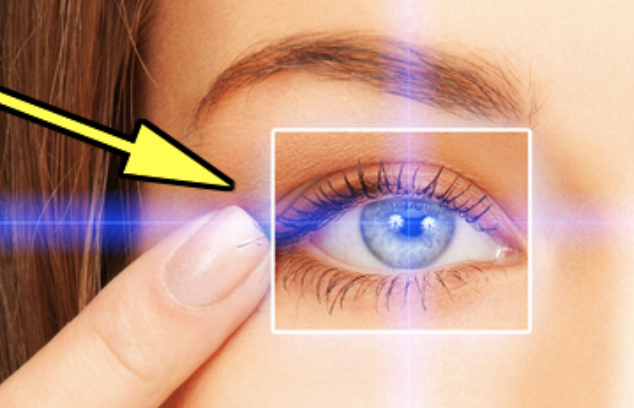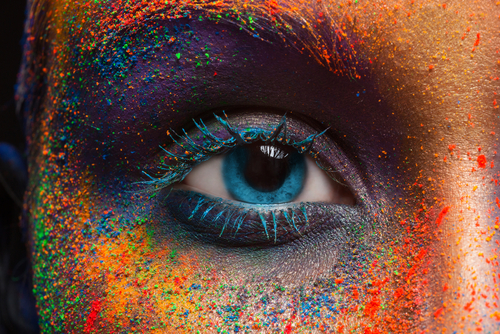Does Your Eyes Ever Twitch? Doctors Say THIS Is What It Means!

image via – shutterstock.com
A twitchy eye can be extremely annoying and uncomfortable. You’ve likely experienced it many times before and it always seems to come out of nowhere. One minute everything is fine and normal and seconds later it feels like your eye is about to jump out of the socket.
The nerve or muscle or whatever the heck it may be is spasming and shaking all around, making you squint and worry about what is actually going on in there. If you have ever wondered what is causing your eye to twitch and whether or not you should be worried about it, here is the answer.
There are several different types of eye twitching and each one is considered a separate condition from the rest. They are all caused by different things and the most common type, that you have likely experienced, is called eyelid twitching or myokymia.
The Mayo Clinic describes it as “affect[ing] only the eyelid. It can involve either the upper or lower lid, but only one eye at a time. The eye twitching can range from barely noticeable to bothersome. The twitching usually goes away within a short time but may recur over a few hours, days or longer.”
The twitching is caused by tiny muscles and nerves located around your eye. Just like any other muscle that suddenly spasms out of control, the ones in your eye can as well. There is nothing serious about this type of twitch and it’s relatively normal.
A less common type of twitch you should be worried about is called a blepharospasm, which is when a twitching in both of your eyelids gradually increases and worsens. It gets to a point where the intensity and strain of the twitching becomes too much and may even lead to near or complete blindness. However, this is a very rare occurrence and if it ever happens to you, see a doctor immediately.
While doctors and scientists have yet to agree on what exactly causes our eyelids to twitch, they have narrowed down some of the main factors that contribute to it. In the accompanying video Dr. Matthew Palmer, O.D., from the Southwestern Eye Center explains the basics about eye twitching and reassures us all that it isn’t a major health issue or concern.
In fact, it’s the opposite and normal, many people experience it throughout their lifetime. Here are a few basic things you can to to cut down on the frequency and severity of when it happens to you:
1) Relax and De-stress- The less stressed you feel, the less likely you are to end up experiencing an eye twitch. Stress is believed to be one of the main causes of myokymia and it’s also an aggravating factor which will make your twitch stronger and thus worse.
2) Get a Full Night’s Sleep- A lack of good, quality sleep can wreak havoc on your body, especially your eyes. Having to focus and re-focus a countless amount of times each day is hard on your eye muscles and they get fatigued just like any other muscle in your body. Not getting enough sleep also adds further stress to our lives and bodies, so rest your eyes and try to get as much sleep as possible.
3) Caffeine- If you really have eye twitch problems, cut the caffeine out of your diet because it can trigger them. Caffeine also causes our bodies to release serotonin and noradrenaline, two chemicals that stimulate and excite our nerves, which an lead to more frequent and severe eye spasms.
These three factors all contribute to eyelid twitching, but there may be other potential causes. If you have an eye twitch issue that is extremely annoying, frequent, and bothersome, there are medications that can help with it. Botox has also been shown to be effective at managing and controlling the muscles around the eye and can help with twitching.
However, most of the time the spasms will go away on their own and are not so severe that they greatly impact our quality of life. Finally, there are no neurological problems associated with a twitchy eyelid, so don’t worry about experiencing them or freak out when they happen.
It’s a normal occurrence and should pass in a few seconds or minutes.
Please Share This With Your Family and Friends
Do You Have The Magic Eye? Can You See These Hidden Images?

image via – shutterstock.com
Do you remember how back in the mid-90s all of those Magic Eye books were a smash hit? In fact. the original three book series were so popular that they ended up topping the New York Times best seller list for weeks and weeks on end.
The awesome pictures featured on the glossy pages are called autostereograms. They’re the magic behind the illustrations because they are a special type of 2D image designed to contain 3D images hidden within them.
Autostereograms, the ones we are familiar with, were originally invented by Bela Julesz. He was a visual neuroscientist and psychologist who was trying to prove a theory he came up with, which was that depth perception occurred in the brain and not the eyes.
At the time, this was the common belief and so he set out to test people’s ability to see in 3D with images he created that were similar in type to the modern day Magic Eye version. It turned out that the visual illusion’s he developed proved his theory correct and years later they evolved into the Magic Eye images that we all know and love!
If you’re anything like me, then you likely have trouble spotting the hidden images in the pictures. This is due in part because of the need for us to adjust our eyes and change the way we normally perceive depth. If you are able to successfully do this, the hidden 3D image will appear out of the patterned image you’re staring at.
So how do you change your natural depth perception abilities? Good question and here is a breakdown of the instructions from the Magic Eye website on how to best view the images:
Start by looking at the center of the image extremely close up. The computer or page should practically be touching the tip of your nose.
Next, adjust your focus. It helps to try and look right through the picture, off into the distance.
Now slowly begin to steadily move the picture away from your eyes until the 3D image pops out at you.
If you’re still unable to see after trying all of the above, then you may have to move the image back towards you and closer to your face, or further away. Finally, you may also need to start all over so you can re-set your eyes and focus.
Also, when you’re able to see the hidden image allow your eyes to adjust a tad bit more. This will make it become clearer and much more defined. At that point you’ll be able to see more of the depth and details within it.
For those out there who are not be able to see anything, don’t worry! It’s hard to adjust your eyesight in order to be able to see past the 2D image. If you happen to be one of them, don’t give up! Keep trying and you should eventually be able to crack the brain/eye barrier that’s making you trip up.
Test out your Magic Eye abilities right now by working through the images below and see how skilled you are at perceiving the 3D images. Good luck and enjoy!
Please SHARE This With Your Family and Friends
This Color Is Breaking The Internet Appearing Different To Everyone! Is It Green Or Blue To You?

The internet has become divided yet again over what shade of color people are seeing. This time it’s not the infamous dress of yesteryear that appeared to be either black and blue or gold and white. Now it’s simply one color that is splitting people up in two distinct camps and it’s those that see blue versus those that see green. Check out the color below and decide for yourself which one you see!
Optical Express, a company based in the United Kingdom, conducted a public survey on color perception in which they asked people to identify the color as belonging to either the blue or green color family. At first glance, 64% answered green and 32% answered blue.
The same participants were then asked to identify the same color once again, but this time it was in-between two colors that were clearly blue. The second time around a whopping 90% responded that the color was green! According to the Optical Express website, the color is in fact more green than blue, and this becomes much more clear when it’s placed next to shades that are definitely blue.
However, the real lesson to take from all of this is that how we see and visually interpret the world can drastically differ from one person to the next. It’s not only that particular shade of color we see differently, that’s a very basic example, it can be anything else we’re visually perceiving that may be different..
Amazing how one little swatch of color can spark such interest and illustrate how unique we all are. Share this with your friends and family and see what color they think it is!
What color do you see? let us know in the comments
Please SHARE This With Family and Friends To Find Out What Color They See




